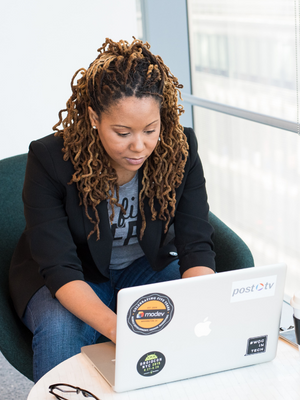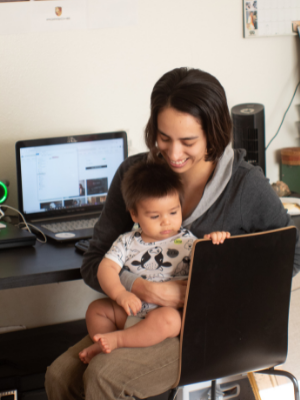 The meeting that catalyzed me to become my own boss feels like it happened yesterday.
The meeting that catalyzed me to become my own boss feels like it happened yesterday.
I was working as the director of content development for peak performance coach Tony Robbins and was called into a meeting. Online education was just starting to take off, and Tony had invited some of the most successful entrepreneurs in this space to come in and share their experiences.
These men — and they were all men — had hugely successful digital courses, online membership programs, and mastermind groups. We were exploring how we could add this strategy to our business.
My job was to sit there quietly and take notes. And since women hold only 8.2% of CEO roles, this dynamic didn’t seem unnatural to what I was used to. But as I was taking notes, everything started to change for me.
I realized I wanted a seat at the table, not just near it. I wanted to be a part of changing statistics like the global gender pay gap – currently estimated to be 16%, meaning women earn an average of 84 cents for every dollar men earn.
And finally, I realized I wanted to be part of the 12 million women-owned businesses in the US that generate over $1.8 trillion in revenue and employ over 9.4 million people.
So I decided to start my journey towards these desires right then and there in the meeting. I paid close attention to what these powerful business owners were sharing, and today, I want to pass along three lessons I learned to help you build the business – and life – of your dreams, too.
1. It is possible to design your life on your own terms.
As I listened to those entrepreneurs talk about their businesses, I realized something that changed how I thought about my career path. These men were all in different industries but had one thing in common: freedom. They weren’t hitting the glass ceiling. They weren’t asking for permission. They were taking charge of their own destiny.
Without knowing it, women let outside forces shape their destinies all the time. Just look at the latest PitchBook data showing how startups with all-women teams receive a mere 1.9% of the 238.3 billion dollars of venture capital awarded each year.
But these men… in this meeting? They were calling the shots and not waiting for someone to give them a green light on their business ideas.
They were achieving business success while designing a life on their own terms. And I wanted to do that too.
For me, the answer was to build my own business and be my own boss. I wanted to do work I loved and do it how, when, and where I chose. That would be designing life on my own terms.
When I started exploring what life on my own terms looked like, I remember reaching out to a business owner and boldly asking: “I know you don’t offer this as a service, but could I pay you for an hour to ask how you built your business?”
She said yes, and I spent that hour under my desk whispering into the phone as she broke down steps to get started, how to align a business with personal values, and how she brought her vision to life on her terms.
It wasn’t glamorous, but it was just what I needed.
She could have said no, and if that happens to you, I want you to look at that “no” as bringing you one step closer to a “yes.” Keep reaching out and asking people for advice. Eventually, a door will open.
And mentors like this don’t have to come in the form of a person, either. Books like Big Magic by Elizabeth Gilbert showed me how my ideas were a big enough deal that I could build a business around them.
The message she shares in the book about how you can either go all in and share your gifts with the world, or dismiss them, resonated with me and served as the kick in the pants I needed to get crystal clear on how I wanted to impact the world.
A life designed on your terms might look different than mine. That’s the beautiful thing: You have the power to choose your path. And once you do, I encourage you to find a mentor to guide you as you walk down it toward your dream life!
2. Your existing knowledge and skills are more valuable than you think.
As I listened to the men in that boardroom talk about the online courses they were selling, I took note of their success. Each one had taught hundreds or even thousands of students, creating a massive impact in their field. From dating advice to real estate investing, they were transforming lives. It was truly inspiring.
I also took note of what they didn’t say. None of them talked about investing years and years into certification and education before they created their first course. They didn’t go back to school to earn a business degree before they launched. They weren’t wracked with fear about staying on top of their game.
In fact, whether you’re starting your own business or applying for a new job, this seems to be a common theme. A Hewlett Packard report found that while men apply for a job if they meet only 60% of the qualifications, women tend to apply only if they meet 100%. That stops now – you know enough to take the first step!
Your knowledge today has enormous value if you share it with the right audience. Whether you are starting an online education business of your own or continuing a professional career, the key is to look for places where you have a 10 percent edge.
If you are at least 10 percent ahead of those you serve, you can lead the way. In fact, it’s sometimes easier to lead when you aren’t too far out in front.
3. Boss traps are a barrier to success.
The third thing I noted during the meeting was that these highly successful entrepreneurs had faced their share of problems. Yes, a professional career comes with challenges. But becoming your own boss isn’t always smooth sailing either.
As I started my own business, I discovered that many of the traps you fall into as a boss stem from “demoting” yourself and not embracing the full scope of your role. You may experience some of these in your career as well. For example, one of the most common boss traps is falling prey to superwoman syndrome and trying to do everything yourself.
A study by the U.S. Bureau Of Labor Statistics found that 20% of businesses failed within the first year, and I believe many are due to superwoman syndrome.
There are so many stories of entrepreneurs who had to learn this lesson the hard way, from Arianna Huffington, the co-founder of The Huffington Post, to Sophia Amoruso, founder of Nasty Gal.
In 2007, after launching the news site, Huffington became consumed by the demands of running the business and regularly worked 18-hour days. In 2007, she collapsed from exhaustion and hit her head, resulting in a broken cheekbone and stitches.
This experience prompted her to reassess her priorities and make changes in her life and work. She stepped down as editor-in-chief of The Huffington Post in 2016 and launched Thrive Global, a company focused on wellness and reducing burnout.
Huffington has since spoken about the importance of taking care of oneself and avoiding the trap of “superwoman syndrome” in order to be successful in business.
Sophia Amoruso is another example of a founder falling into the “superwoman syndrome” trap. She launched the online clothing retailer Nasty Gal in 2006 as an eBay store and grew it into a successful brand with over $100 million in annual revenue.
However, Amoruso took on too much work herself and ultimately experienced burnout. In 2015, Amoruso stepped down as CEO of Nasty Gal after the company filed for bankruptcy.
She has since gone on to start a new company, Girlboss, which aims to provide resources and a community for women entrepreneurs. Amoruso has spoken publicly about the lessons she learned from her experience with Nasty Gal, including the importance of delegation and self-care in avoiding burnout.
I tell you these stories not to discourage you, rather, to remind you that none of us magically wake up one morning feeling like a “boss babe” from Instagram. It takes time, experience, and a willingness to change to become a leader who can live life on her terms.
You absolutely deserve to get there. And along the way, don’t forget to take off your superwoman cape and ask for help so you can bring people along for this incredible journey you’re starting! It’s like the legendary leader John Maxwell says, “Leadership doesn’t involve being ‘lonely at the top.’ If you’re at the top of a mountain alone, you’re not a leader, you’re a hiker.”
Dream big, but don’t stop with a dream. As quickly as possible, take a step toward that dream. Action creates clarity, and clarity will propel you to more action.
Don’t wait. I know you’ve got this.
Amy Porterfield teaches eight best-selling courses that empower women across the globe to take their futures into their own hands. She hosts the top-ranked marketing podcast Online Marketing Made Easy and author of the new book, Two Weeks Notice: Find the Courage to Quit Your Job, Make More Money, Work Where You Want, and Change the World.
(The opinions and views of guest contributions are not necessarily those of theglasshammer.com).










